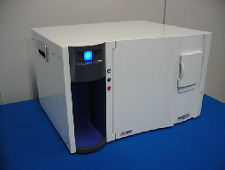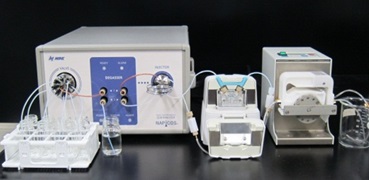QCM Sensor
NDK introduces liquid-phase biosensors (mainly biomolecular interaction analyzers, etc.) and gas-phase gas sensors and outgas sensors using the QCM method. QCM is short for “Quartz Crystal Microbalance,” and is a method of measuring micro mass changes using a crystal unit as a sensor.
We offer the world's first double-electrode type “QCM Twin Sensor” as a QCM sensor. With it, it is possible to perform differential measurements with reduced noise effects by using one side as a reference. By coating an antibody, etc. on the sensor electrode, the substance to be measured can be captured and quantitated. We also offer conventional single-electrode type QCM sensors. Lead type QCM sensors suitable for gas-phase measurements and glass epoxy substrate type QCM sensors for liquid-phase measurements are available.
Outgas measurement sensors are provided as QCM sensor modules.
The NAPiCOS series for gas and liquid phase measurements and the Twin-QCM system for outgas measurement in vacuum are available for the QCM system. Both systems support differential measurements with a single sensor, which was impossible in the past.
With the NAPiCOS series, NAPiCOS Auto (automatic measurement type) is available as a liquid-phase measurement system for real-time measurement of interactions between substances, such as immune reactions.
NAPiCOS Auto is equipped with a built-in pump, injector, degasser, etc., and can perform advanced measurements under automatic control.
In addition, the NAPiCOS system that supports both 9MHz and 30MHz sensors as a dedicated gas-phase measurement system and the automatic measurement system (NAPiCOS Auto TS) that has been optimized for taste measurement are also available. Also, with the Twin-QCM system, outgas contained in organic materials can be measured by the QTGA method (*1). It can be used to select and evaluate materials for space applications.
(*1) QTGA (QCM Thermo-Gravimetric Analysis)
The QCM thermo-gravimetric method measures the evaporation rate of the adhered material by increasing the temperature at 1°C/minute after the outgas is adhered at a low temperature.
This is a measurement method that applies the QCM method based on the “mass load effect,” in which when a substance adheres to the electrodes of a crystal unit, the frequency decreases in proportion to the mass of the substance.
Product Lineup
QCM Twin Sensors for NAPiCOS Series
| Model | Nominal Freq. (MHz) |
Blank Cut angle | Blankshape | Diameter of blank (mm) |
Holder | Electrode | Operating Temperature Range (°C) |
RoHS | Pb Free | ||
|---|---|---|---|---|---|---|---|---|---|---|---|
| Shape | Material (Surface+ground) |
||||||||||
| PSA-SB-3002T | 30 | AT cut | Circle plate | Φ8.7 | FR-4 | Twin | Au+Cr |
|
|
|
|
*Production of the 30MHz twin sensor φ14mm product (model name PSA-SE-3002T) has been completed.
*Specifications and product names described in this site are subject to change for improvement without notice. The products are subject to production stoppage without notice
Other QCM Sensors
| Model | Nominal Freq. (MHz) |
Blank Cut angle | Blankshape | Diameter of blank (mm) |
Holder | Electrode | Operating Temperature Range (°C) |
RoHS | Pb Free | ||
|---|---|---|---|---|---|---|---|---|---|---|---|
| Shape | Material *1 (Surface+ground) |
||||||||||
| PSA-SL-0901T | 9 | AT cut | Circle plate | Φ8.7 | Lead type | Single | Au+Cr |
|
|
|
|
| PSA-SL-3001T | 30 | AT cut | Circle plate | Φ8.7 | Lead type | Single | Au+Cr |
|
|
|
|
*1:Besides the above electrode materials , Ag + Al (for surface) and NiCr + Ti (for ground) are available.
*Production of PCB-type sensors (model name PSA-SB-0901T and PSA-SB-3001T) has been terminated.
*Specifications and product names described in this site are subject to change for improvement without notice. The products are subject to production stoppage without notice
| Product Name | Outward Forms |
|---|---|
| NAPiCOS Auto |
|
| NAPiCOS System |
|
| NAPiCOS Auto TS |
|



